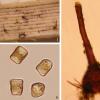
17-01-2026 19:35
Arnold BüschlenHallo, ich suche zu Cosmospora aurantiicola Lite

08-12-2025 17:37
 Lothar Krieglsteiner
Lothar Krieglsteiner
20.6.25, on branch of Abies infected and thickened

16-01-2026 00:45
Ethan CrensonHi all, On decorticated hardwood from a New York

10-01-2026 20:00
Tom SchrierHi all,We found picnidia on Protoparmeliopsis mur

13-01-2026 07:28
 Danny Newman
Danny Newman
Chlorociboria glauca on indet. decorticate logThe

15-01-2026 15:55
 Lothar Krieglsteiner
Lothar Krieglsteiner
this one is especially interesting for me because

13-01-2026 08:43
 Danny Newman
Danny Newman
Tricladium varicosporioides on indet. decorticate
Dear Dr. Malloch,
we saw in the forum your chat with Pimpek and we're interested in Scopinella's papers, too.
We have found a specimen of Scopinella on leaves of Cortaderia selloana (Poaceae) and we think it could be a new species. However we haven't got bibliographic material about S. gallicola and S. pleiospora.
We attached a plate. The ascospores are 7.5-9.5 x 5.5-8.5 µm.
Best wishes,
Lucrecia, Virginia and Romina

(if I may "chip in") nothing on S. pleiospora, but this the description of S. gallicola (from "Scopinella gallicola, a new species from rust galls of Endocronartium harknessii on Pinus contorta" A . TSUNEDA AND Y . HIRATSUKA (CJB vol. 59)
TYPUS: In gallis Endocronartii harknessii (J. P. Moore) Y . Hiratsuka in Pinus contorta Dougl . var. latifolia Engelm. , CF B 20831.
Ascocarps nonstromatic, superficial; bases globose, at first hyaline and semitransparent, then becoming dark brown to black, 80-230 p.m diameter, with thick-walled peridial hyphae, hyaline, brown at the base, up to 150 x 5 p.m; necks straight or slightly bent, dark brown to black, pale or hyaline at the apices, slightly tapering toward the apices, mostly 230-370 u.m long, (18—)30— 45(-55) p,m wide; ostiolar hyphae rarely present.
Ascocarp peridium, dark brown to black, two- to five-layered, 9-25 p-m thick. Peridial cells isodiametric in surface view, 3-17 p.m diameter, 2- 7 p.m thick, with moderately thick walls 1-2 p.m thick. Paraphyses moniliform, 2.5-8.0 p,m diameter. Asci lining sides of the centrum wall , hyaline, 2- to 4-spored, clavate, usually short-stipitate, soon becoming evanescent, 12 - 26 x 5.0-7.5 p.m. Ascospores unicellular, barrel-
shaped, pale brown, brown to black in mass, hyaline at the ends, smooth, 3.5-8.0 x 2.9-6.5 p.m. ?
clearly a different taxon to what you have found
un cordial saludo! / best wishes
Chris
Hello Chris,
you're right, S. gallicola has nothing to do with our species. Thank you very much for the information!!!
Regard to S. pleiospora, we found it in the Index Fungorum (www.indexfungorum.org) list of Scopinella's species and we don't know when it was rejected as a member of the genus.
Cordialement,
Lucrecia, Virginia and Romina


